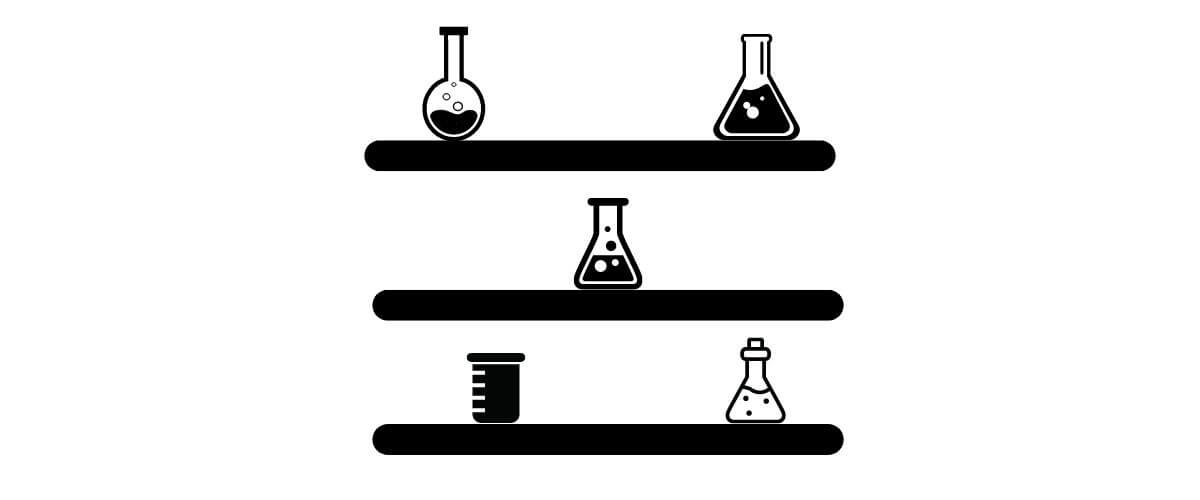
Chemical storage is an important aspect of laboratory function. Your chemical storage requirements will vary depending on what type of laboratory you are running and what types of research or experiments are being performed, but most branches of science do require chemicals of some kind in the lab.
In order to have a good workflow and a safe laboratory environment, it is vital that you know how to properly handle and store chemicals.
Why Chemical Storage Is Important
If you aren’t storing your chemicals properly, you incur a number of risks. Even something as common and seemingly innocuous as ethanol actually does pose a risk if stored incorrectly.
Here are just a few of the unnecessary risks of improperly stored chemicals:
- Need to replace chemicals more frequently due to unexpected loss from evaporation or other poor storage conditions
- Unwanted reactions caused by the unplanned mixture of chemicals or their byproducts like fumes and vapor. This can result in severe damage or toxic exposure.
- Small incidents scaling up due to other materials stored in the vicinity; for example, a small fire that rapidly grows larger due to readily available, improperly stored chemicals acting as fuel.
- Delays in emergency services’ on-site response due to uncertainty over potential chemical exposure
- An unsafe environment for everyone in the building
Ensuring Chemical Storage Safety
Proper lab protocols will let your lab employees know the procedures for safe chemical handling, transportation, and storage. Each type of volatile chemical has its own best practices for safe storage.
There are three main principles of chemical storage safety: separation, segregation, and ventilation.
Separation
Some chemicals are incompatible with their storage needs. Others run the risk of reacting to other chemicals.
Still, more may be toxic or too highly reactive to be stored with other chemicals. Lab chemical storage cabinets that are uniquely dedicated to one category of chemicals will keep them separated safely.
Segregation
Segregation means that you keep chemicals that will react away from each other. For example, it’s important to store strong acids away from strong bases. Strong oxidizers should be kept away from organic or flammable chemicals, and highly flammable chemicals should be kept away from all other materials in their own designated cabinet.
Ventilation
Chemical storage ventilation is frequently extractive in nature, using exhaust fans and ductwork to dilute and extract toxic, corrosive, or otherwise harmful vapors and fumes. Containers may have leaks, lids may be improperly replaced, and dozens of other minor issues that can escalate rapidly mean that it’s better to be safe than sorry and have some type of ventilation in your cabinets.
The Dos and Don’ts of Chemical Storage
Here are some general tips on how to store chemicals in the laboratory.
Do:
- Clearly label all chemicals so that the contents are easily identifiable at a glance
- Physically separate incompatible chemicals.
- Segregate your chemicals by risk type.
- Keep strong acids and bases in different cabinets, far away from each other.
- Keep good records of the chemicals’ lifespan. Date the chemicals when received and again when opened. Make sure that dates are clear and legible.
- Only keep chemicals in your storage cabinets.
- Keep your emergency equipment clear of chemical storage.
- Provide specific storage space for each chemical and make sure they are returned after use.
- Store volatile chemicals in ventilated cabinets that comply with your lab’s environmental health and safety guidance.
- Store flammable liquids appropriately.
- Use secondary containers to store corrosive chemicals inside the cabinets.
- Seal containers tightly to prevent vapors escaping and chemical loss due to evaporation.
- Use designated refrigerators for storing chemicals that need to be kept cold, and label them so that nobody puts any food in them. Use designated refrigerators for storing chemicals.
Do not:
- Store chemicals on benches or on desktops
- Store chemicals in fume hoods or under sinks (this includes ethanol)
- Expose chemicals to excessive heat or direct sunlight.
- Store hazardous materials above the shoulder height of the shortest person in the lab– you should never reach up to bring hazardous chemicals down, as it incurs a greater risk of spillage.
- Store anything on top of cabinets.
- Store bottles on the floor without secondary containment.
- Store large gas canisters without chaining them to the wall.
- Put flammable liquids in a refrigerator unless it is specifically designed to be explosion-proof/spark-free and is approved for flammable chemical storage.
Chemical Storage Safety Resources
Chemical storage is a serious concern, and there are many good resources to consult for best practices. These three, however, are absolutely necessary for all lab managers to read and understand.
There are many legal and liability concerns regarding the storage of hazardous chemicals, and following the standards of chemical storage is one way to ensure that your lab is as safe as possible.
- Prudent Practices in the Laboratory: Handling and Disposal of Chemicals is the National Academy of Science’s guide to chemical safety
- The NFPA 400 is the National Fire Protection Association’s consolidated guide to the fundamental safeguards for the storage, use, and handling of hazardous materials in all occupancies and facilities.
- OSHA 1910.1200 is an occupational safety and health standard that comprehensively addresses the issue of classifying the potential hazards of chemicals and communicating information concerning hazards and appropriate protective measures to employees.
Hazardous Chemical Storage Requirements
All hazardous chemical storage must be identified with the NFPA 704 Hazard Diamond. This imagery is a quick way for emergency responders to identify the risks of laboratory chemicals during a fire or other emergency. The Hazard Diamond may be accompanied by OSHA’s HazCom 2012 documentation.
While clear labeling and using hazard communication signs is the first step toward hazardous chemical storage safety, there are many other contributing factors to safe storage in the lab.
Toxic Chemical Storage
Toxic compounds, like all chemicals, must be clearly labeled. Every component of a toxic chemical needs to be clearly identified on its storage container, without using abbreviations, and in good, legible handwriting or typing. This is so that if any of the material is contacted or ingested, it can easily be communicated to Poison Control.
A Poison Control Network telephone number should be posted in the laboratory. This information should include the local Poison Control number and the national hotline, 1-800-222-1222.
Toxic compounds may require additional security, such as a lock on the cabinet and additional monitoring or signing out when used. This varies from case to case, and your lab may not require it.
Corrosive Chemical Storage
Corrosive chemicals are either strong acids or strong bases. Both must be kept away from each other.
Large bottles of corrosive chemicals should be stored on lower shelves or in dedicated cabinets, especially if they are acids.
Acids should be further segregated into oxidizing acids and organic acids, and acids should be kept away from active metals like sodium, magnesium, and potassium. You should also keep acids away from chemicals that can generate toxic gasses on contact, such as sodium cyanide and iron sulfide.
Both acids and bases should be stored in chemical-resistant trays that are capable of containing any spillage or leakage from their container. These trays go in the designated cabinets for acids and bases and will serve as secondary containment for these chemicals.
Flammable Chemical Storage
Flammable chemical storage is often subject to state or local regulations that are imposed over corporate rules. It is always important to be aware of local fire codes when designating space for flammable chemical storage.
If you have flammable chemicals that need to be kept cold, you cannot use a standard refrigerator or freezer to store them. These have electrical components in their storage compartments that could cause a spark.
Make sure that any refrigeration unit that you use for flammable chemicals is spark-free; check with your local fire marshall if you are unsure about your refrigerated storage.
There is also a limit to the number of flammable chemicals that can be stored safely in a lab. The NFPA has two guidelines, NFPA 30 and NFPA 45, that determine how much flammable material one lab can store. For each area with flammable liquids, you can safely store 10 gallons per 100 square feet in a lab without sprinklers, and 20 gallons per 100 square feet in a lab with sprinklers.
The maximum allowable quantity for flammable liquid storage in any size lab is not to exceed 120 gallons.
- Regarding flammable liquid storage outside of approved flammable storage cabinets; there may be a maximum of 10 gallons of flammable liquids in original containers and an additional 25 gallons in approved safety cans not to exceed 2-gallon size. NFPA 45.
- NFPA-specified safety cabinets should be used for storage of flammable liquids.
- Only explosion-proof or intrinsically safe refrigerators and freezers should be used for storing flammable liquids.
- Bonding and grounding wires should be used where flammable liquids > 5 gallons are dispensed or where flammable liquids are being transferred from one metal container to another metal container.
What Makes a Good Chemical Storage Cabinet?
Not all cabinets should be used for chemical storage. They may need to be ventilated and should be made from chemical-resistant materials, like stainless steel. Additionally, SEFA certification means that your casework meets advanced safety standards.
The easiest way to ensure that your laboratory furniture meets your chemical storage needs is to get custom furniture made just for you. At OnePointe Solutions, our laboratory casework is fully customizable and can be built to fit your exact specifications.
We test our furniture for SEFA compliance, and we design lab furniture that fits all of your space’s requirements. Call us at 866-612-7312 to schedule a free consultation today!


